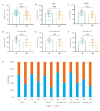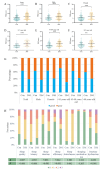Mediating role of sleep quality in the relationship between diabetes mellitus and visual function: a cross-sectional study
- PMID: 40594872
- PMCID: PMC12215745
- DOI: 10.1038/s41598-025-06641-2
Mediating role of sleep quality in the relationship between diabetes mellitus and visual function: a cross-sectional study
Abstract
Diabetes mellitus (DM) is a major global health concern associated with complications that significantly impair quality of life. Among these, the impact of DM on visual function and the underlying mechanisms, particularly the role of sleep quality, remain insufficiently understood. This cross-sectional study recruited 629 participants from Henan Provincial People's Hospital to examine the relationships among DM, sleep quality, and visual function. Visual function was assessed using the National Eye Institute Visual Function Questionnaire-25 (NEI-VFQ-25), while sleep quality was evaluated with the Pittsburgh Sleep Quality Index (PSQI). Compared to non-diabetic controls, individuals with DM exhibited significantly poorer visual function and sleep quality. Path analysis further revealed that sleep quality played a significant mediating role in the relationship between DM and visual function, accounting for 42.2% of the total effect. Subgroup analyses indicated that female and elderly patients with DM were more susceptible to the influence of sleep disturbances on visual outcomes. These findings underscore the critical role of sleep quality in diabetes-related visual impairment and highlight the importance of incorporating routine sleep assessments and targeted interventions into diabetes management to help preserve visual function and improve overall quality of life in diabetic populations.
Keywords: Cross-Sectional study; Diabetes mellitus; Mediating effect; Sleep quality; Visual function.
© 2025. The Author(s).
Conflict of interest statement
Competing interests: The authors declare no competing interests.
Figures




Similar articles
-
Blue-light filtering spectacle lenses for visual performance, sleep, and macular health in adults.Cochrane Database Syst Rev. 2023 Aug 18;8(8):CD013244. doi: 10.1002/14651858.CD013244.pub2. Cochrane Database Syst Rev. 2023. PMID: 37593770 Free PMC article.
-
Association of alcohol consumption with sleep disturbance among adolescents in China: a cross-sectional analysis.Front Public Health. 2025 Jun 16;13:1564292. doi: 10.3389/fpubh.2025.1564292. eCollection 2025. Front Public Health. 2025. PMID: 40589804 Free PMC article.
-
Sleep quality as a mediator between family function and life satisfaction among Chinese older adults in nursing home.BMC Geriatr. 2024 Apr 29;24(1):379. doi: 10.1186/s12877-024-04996-1. BMC Geriatr. 2024. PMID: 38684958 Free PMC article.
-
Community screening for visual impairment in older people.Cochrane Database Syst Rev. 2018 Feb 20;2(2):CD001054. doi: 10.1002/14651858.CD001054.pub3. Cochrane Database Syst Rev. 2018. PMID: 29460275 Free PMC article.
-
Vision screening for correctable visual acuity deficits in school-age children and adolescents.Cochrane Database Syst Rev. 2018 Feb 15;2(2):CD005023. doi: 10.1002/14651858.CD005023.pub3. Cochrane Database Syst Rev. 2018. PMID: 29446439 Free PMC article.
References
-
- International diabetes federation diabetes atlas. 10th Edition. [Internet] (2021, accessed 13 Aug 2024). http://www.diabetesatlas.org/.
-
- Azharuddin, M., Kapur, P., Adil, M., Ghosh, P. & Sharma, M. Health-related quality of life and sleep quality among North Indian type 2 diabetes mellitus patients: evidence from a cross-sectional study. Sleep Med.73, 93–100. 10.1016/j.sleep.2020.04.022 (2020). - PubMed
-
- Birhanu, T. T., Hassen Salih, M. & Abate, H. K. Sleep quality and associated factors among diabetes mellitus patients in a Follow-Up clinic at the university of Gondar comprehensive specialized hospital in gondar, Northwest ethiopia: a Cross-Sectional study. Diabetes Metabolic Syndrome Obesity: Targets Therapy. 13, 4859–4868. 10.2147/dmso.s285080 (2020). - PMC - PubMed
-
- Ponomareva, M., Petrova, Y. & Gribanova, E. Visual prognosis and sleep quality in patients with chronic kidney disease. Med. Sci. Educ. Ural. 22, 63–66. 10.36361/1814-8999-2021-22-3-63-66 (2021).
MeSH terms
Grants and funding
- LHGJ20210071/Henan Provincial Medical Science and Technology Research Joint Co-construction Project
- LHGJ20220085/Henan Provincial Medical Science and Technology Research Joint Co-construction Project
- 22JCQN004/Basic Science Project of Henan Eye Institute/Henan Eye Hospital
- 21JCZD001/Basic Science Project of Henan Eye Institute/Henan Eye Hospital
- 2018YFC0114500/Ministry of Science and Technology of the People's Republic of China
LinkOut - more resources
Full Text Sources
Medical

